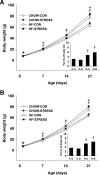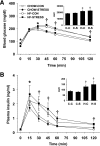Prenatal stress or high-fat diet increases susceptibility to diet-induced obesity in rat offspring
- PMID: 19188431
- PMCID: PMC2671057
- DOI: 10.2337/db08-1129
Prenatal stress or high-fat diet increases susceptibility to diet-induced obesity in rat offspring
Abstract
Objective: Perturbations to the prenatal environment have been associated with the development of adult chronic disease, findings that gave rise to the "Barker Hypothesis" or the "developmental origins of adult disease" concept. In this study, we used an animal model to determine the metabolic consequences of maternal prenatal stress and high-fat feeding on the developing offspring.
Research design and methods: Pregnant female Sprague-Dawley rats were maintained on standard chow or 60% high-fat diet throughout gestation and lactation. Half of each group were exposed to a novel variable stress paradigm during the 3rd week of gestation, whereas control dams were left undisturbed. Body weight, body composition, glucose tolerance, and endocrine parameters were measured in offspring through early adulthood.
Results: Male and female pups from dams that experienced prenatal stress and/or were on a high-fat diet weighed more beginning on postnatal day 7 compared with standard chow-control pups. Access to high-fat diet at weaning increased the body weight effect through early adulthood and was attributable to greater adiposity. Pups weaned onto standard chow diet showed no significant difference in glucose clearance or insulin secretion. However, pups weaned onto high-fat diet had impaired glucose tolerance if their dams were on a high-fat diet, experienced prenatal stress, or both.
Conclusions: Our data demonstrate that prenatal stress and/or high-fat diet during the intrauterine or postnatal environment affects offspring in a manner that increases their susceptibility to diet-induced obesity and leads to secondary adverse metabolic consequences.
Figures






References
-
- Flegal KM, Carroll MD, Ogden CL, Johnson CL: Prevalence and trends in obesity among US adults, 1999–2000. JAMA 2002; 288: 1723– 1727 - PubMed
-
- Procopiou M, Philippe J: The metabolic syndrome and type 2 diabetes: epidemiological figures and country specificities. Cerebrovasc Dis 2005; 20 ( Suppl. 1:) 2– 8 - PubMed
-
- Ogden CL, Carroll MD, Flegal KM: Epidemiologic trends in overweight and obesity. Endocrinol Metab Clin North Am 2003; 32: 741– 760 - PubMed
-
- Tremblay MS, Katzmarzyk PT, Willms JD: Temporal trends in overweight and obesity in Canada, 1981–1996. Int J Obes Relat Metab Disord 2002; 26: 538– 543 - PubMed
-
- Jebb SA, Rennie KL, Cole TJ: Prevalence of overweight and obesity among young people in Great Britain. Public Health Nutr 2004; 7: 461– 465 - PubMed

